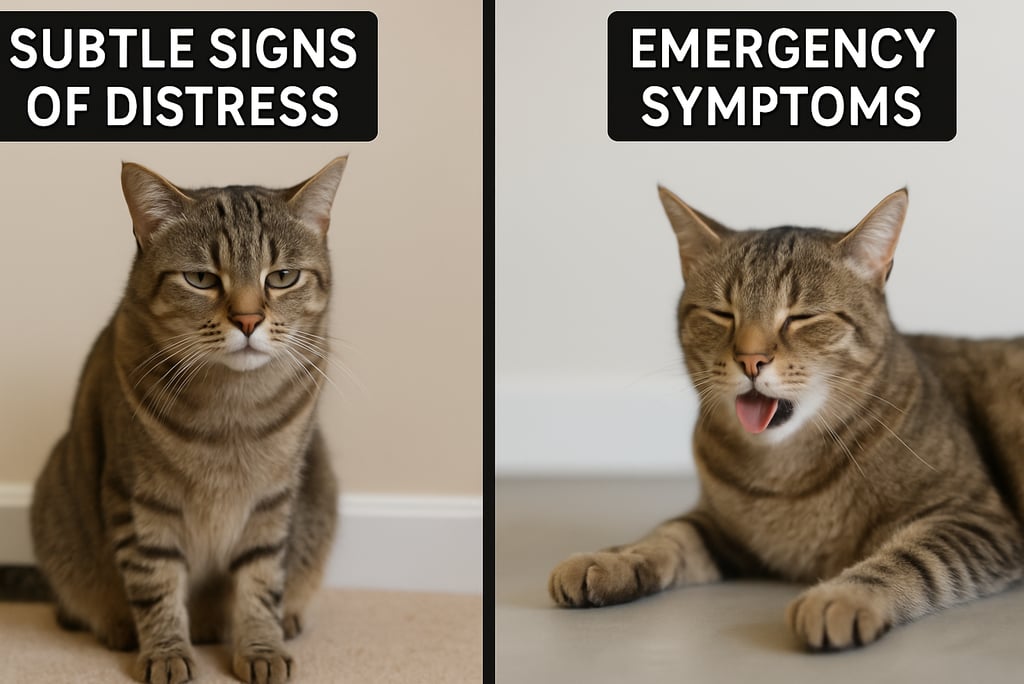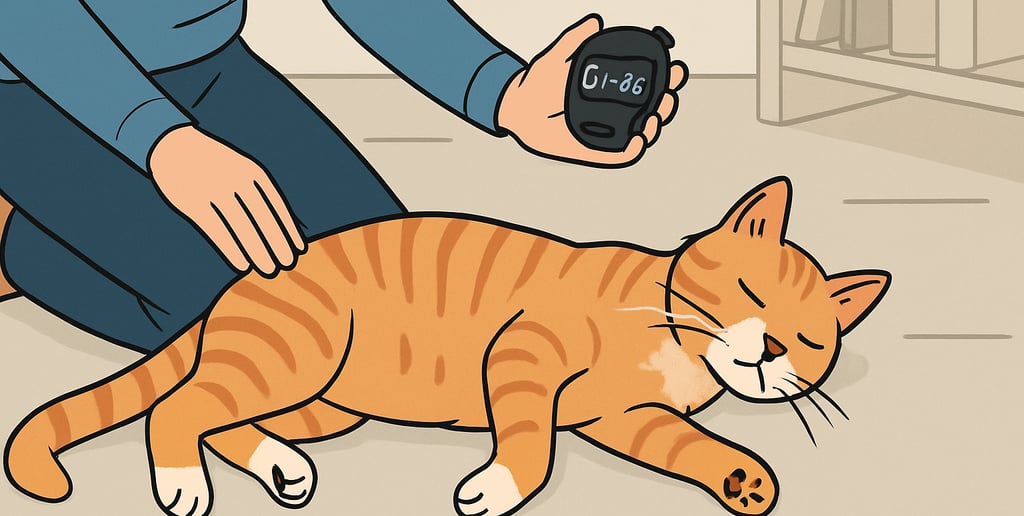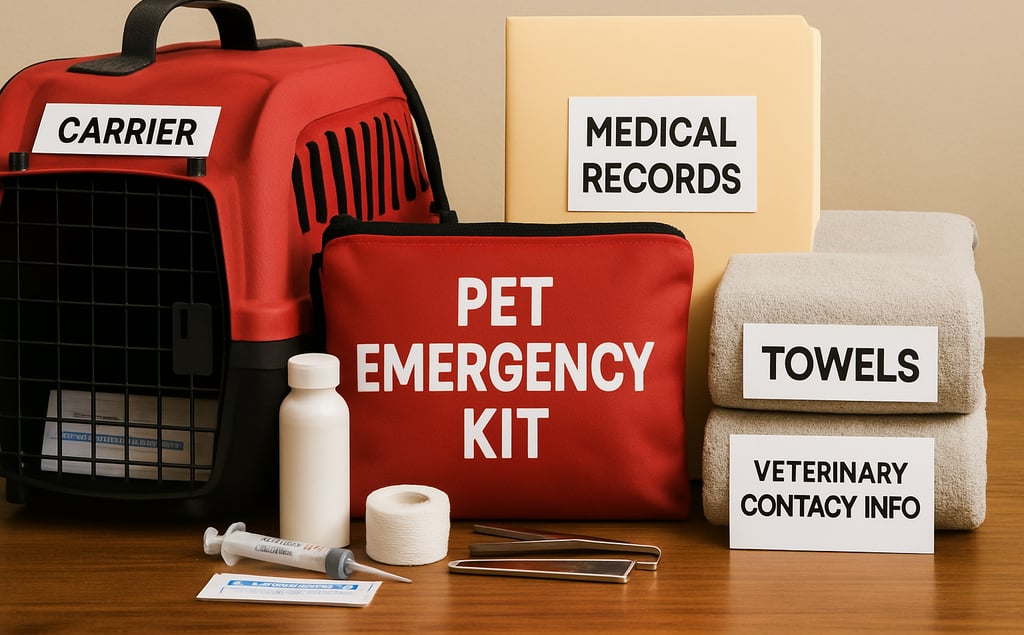Recognizing the Signs: When is a Cat Emergency TRULY an Emergency?
SAFE & NATURAL CARE FOR MINOR EMERGENCIES


Knowing when to rush to the vet versus when to monitor at home can save your cat's life—and prevent unnecessary stress. This guide helps you identify true emergency situations that require immediate professional care.
As cat parents, we've all experienced that moment of panic when our feline friend seems unwell. Is that cough just a hairball, or something more serious? Does that limping warrant an emergency vet visit, or will it resolve with rest? Understanding the difference between true emergencies and minor issues is crucial for providing the best care for your cat while avoiding unnecessary stress and expense.
This article outlines clear red flag symptoms that always require immediate veterinary attention, helping you make confident decisions during worrying moments. Remember that this list isn't exhaustive—when in doubt, it's always better to err on the side of caution and consult a professional.
Life-Threatening Emergencies: When Minutes Matter
Some situations are unmistakable emergencies where every minute counts. If you observe any of these signs, seek emergency veterinary care immediately:
1. Respiratory Distress
Breathing difficulties represent one of the most urgent cat emergencies. Signs include:
Open-mouth breathing or panting (cats should never pant unless extremely stressed or hot)
Labored breathing with exaggerated chest/abdominal movements
Blue or purple gums (cyanosis)
Breathing with neck extended and elbows pushed outward
Noisy breathing (wheezing, gurgling, or stridor)
Rapid breathing rate (over 40 breaths per minute at rest)
Respiratory distress can result from numerous causes including asthma attacks, heart failure, pneumonia, chest trauma, or objects stuck in the throat. Regardless of the cause, difficulty breathing is always an emergency requiring immediate professional intervention.
2. Urinary Blockage
This condition, most common in male cats, occurs when the urethra becomes obstructed, preventing urination. It's extremely painful and can become fatal within 24-48 hours if untreated. Watch for:
Frequent trips to the litter box with little or no urine produced
Straining to urinate with no results
Crying out while attempting to urinate
Excessive licking of the genital area
Vomiting
Lethargy
Abdominal pain when touched
If you suspect your cat cannot urinate, this is an absolute emergency. The buildup of toxins can quickly lead to kidney failure, bladder rupture, and death.
3. Severe Trauma
Any significant physical trauma requires immediate veterinary assessment, even if your cat appears "fine" initially. Internal injuries may not be immediately obvious but can be life-threatening. Seek emergency care after:
Being hit by a vehicle
Falls from significant heights
Animal attacks
Crushing injuries
Any trauma followed by lethargy, hiding, or behavior changes
Remember that cats instinctively hide pain and weakness, so the absence of obvious distress doesn't mean they're uninjured.
4. Prolonged Seizures or Multiple Seizures
Seizures are always concerning and require veterinary attention, but they become a critical emergency when:
A single seizure lasts longer than 2-3 minutes
Multiple seizures occur within 24 hours
Your cat doesn't fully recover between seizures
It's your cat's first seizure ever
During a seizure, move furniture away to prevent injury, keep the room quiet, and time the episode. Never put your hands near your cat's mouth during a seizure, as they may inadvertently bite.
Urgent Situations: Seek Care Within Hours
The following situations may not require the same immediate response as those above but still warrant same-day veterinary attention:
5. Suspected Poisoning or Toxin Exposure
If you know or suspect your cat has ingested something toxic, consider it an emergency. Common household toxins include:
Lilies (all parts are extremely toxic to cats)
Medications (human prescriptions, over-the-counter drugs)
Antifreeze
Rodent poison
Certain essential oils
Household cleaners
String, yarn, or dental floss (can cause intestinal obstruction)
Signs of poisoning vary widely depending on the toxin but may include:
Sudden vomiting or diarrhea
Drooling
Lethargy
Lack of coordination
Tremors or seizures
Difficulty breathing
Pale or yellow gums
If you witness or suspect toxin ingestion:
Remove your cat from the source of poison
Do NOT induce vomiting unless specifically instructed by a veterinarian
If possible, bring the packaging of the suspected toxin to the vet
Contact your veterinarian or an animal poison control center immediately
6. Acute Abdominal Pain
A cat with severe abdominal pain may:
Cry when picked up or when their abdomen is touched
Adopt a hunched position
Resist movement
Guard their abdomen by tensing muscles
Show restlessness or inability to get comfortable
Abdominal pain can indicate serious conditions like pancreatitis, urinary blockage, gastrointestinal obstruction, or internal injury. While not always immediately life-threatening, these conditions can deteriorate rapidly and require prompt veterinary assessment.
7. Persistent Vomiting or Diarrhea
While occasional hairballs or mild digestive upset can often be managed at home, more severe or persistent symptoms warrant veterinary attention:
Vomiting more than 2-3 times in 24 hours
Blood in vomit (may appear bright red or look like coffee grounds)
Projectile vomiting
Diarrhea lasting more than 24-48 hours
Black, tarry stools
Bloody diarrhea
Vomiting or diarrhea accompanied by lethargy, pain, or refusal to eat
Severe vomiting and diarrhea can quickly lead to dangerous dehydration, especially in kittens and senior cats.
8. Eye Injuries
Eye problems can deteriorate rapidly and potentially lead to permanent vision loss. Seek prompt veterinary care for:
Squinting or inability to open the eye
Excessive tearing or discharge
Visible trauma to the eye
Cloudiness or change in eye color
Pupils of unequal size
Rubbing at the eye persistently
Swelling around the eye
Never attempt to remove objects stuck in your cat's eye, and avoid using any eye medications left over from previous conditions or prescribed for humans or other pets.
When Monitoring at Home is Appropriate
Not every health issue requires an emergency vet visit. Some situations where home monitoring may be appropriate include:
A single episode of vomiting in an otherwise normal cat
Mild diarrhea without blood, with normal activity and appetite
Minor limping that improves with rest
Occasional sneezing without other symptoms
Mild scratches or abrasions that aren't deep or bleeding heavily
However, even these "minor" issues should be evaluated by a veterinarian if they persist for more than 24-48 hours or if your cat's overall condition worsens.
Creating an Emergency Plan Before You Need It
The time to prepare for an emergency is before it happens. Take these steps now to ensure you're ready if an urgent situation arises:
Know your veterinary options:
Your regular veterinarian's phone number and hours
The nearest 24-hour emergency clinic location and phone number
A backup emergency clinic in case the primary one is at capacity
Prepare a pet emergency kit including:
Your cat's medical records and vaccination history
Current medications
Recent photo of your cat
Carrier with comfortable bedding
Towels (for wrapping injured cats)
Contact information for your regular vet
Practice carrier training so your cat is comfortable being transported during stressful situations
Consider pet insurance or start an emergency fund to help manage unexpected veterinary expenses
Trust Your Instincts
As a cat parent, you know your feline companion better than anyone. If something seems "off" with your cat, even if you can't pinpoint exactly what's wrong, it's worth consulting a professional. Cats are masters at hiding illness, so subtle changes in behavior or routine can be significant indicators of health problems.
Some changes that might warrant a non-emergency but prompt veterinary visit include:
Decreased appetite for more than 24 hours
Increased thirst or urination
Unexplained weight loss
Changes in grooming habits
Unusual vocalization
New hiding behavior
Lethargy or decreased interest in normal activities
The Cost of Waiting
When in doubt about whether a situation is an emergency, remember that waiting too long can:
Allow a treatable condition to become life-threatening
Increase your cat's suffering
Lead to more complicated and expensive treatments
Reduce the chances of a full recovery
Many emergency clinics offer telephone consultations to help you determine if your cat needs to be seen immediately. Don't hesitate to call and describe your cat's symptoms if you're uncertain.
Balancing Natural Care with Emergency Medicine
While natural and holistic approaches have their place in cat care, they should never delay appropriate emergency treatment. The best approach combines:
Prevention through proper nutrition, environmental enrichment, and regular wellness care
Natural support for minor issues and overall wellness
Conventional veterinary care for emergencies and serious health conditions
This balanced approach ensures your cat receives the most appropriate care for their specific situation.
Our First-Aid Handbook provides a comprehensive list of red flags and guidance on what to do in an emergency, along with natural approaches for minor issues. The Sustainable Cat First-Aid & Minor Issue Handbook empowers you with the knowledge to make confident decisions about your cat's health while honoring your commitment to natural and eco-friendly care.
Disclaimer: This article is for informational purposes only and is not a substitute for professional veterinary advice. When in doubt about your cat's health, always consult with a qualified veterinarian.




Sustainable Cat Care
At EcoCatCare, we provide resources that help cat parents discover how sustainable choices can create healthier, happier lives for their feline companions while contributing to a healthier planet.
EcoCatCare © 2025. All rights reserved
